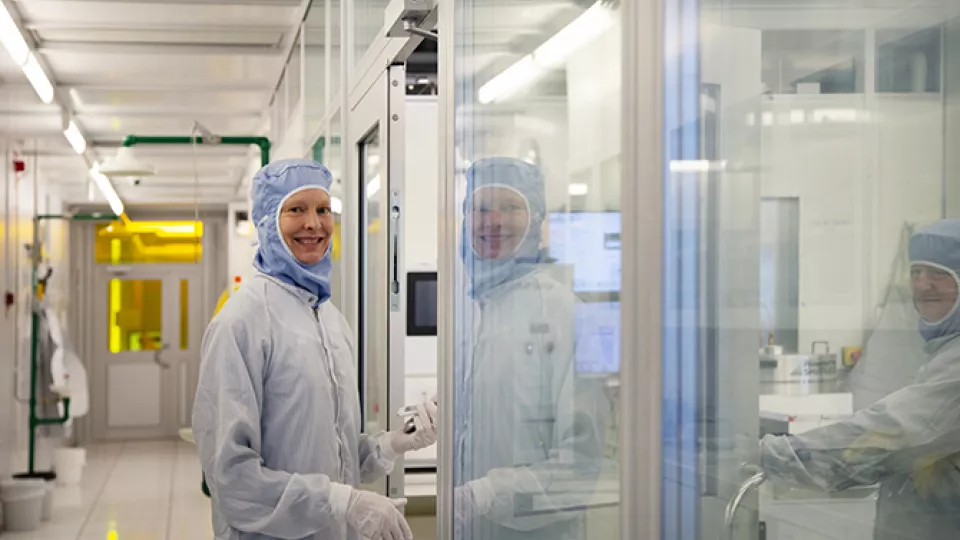Making it big with nano-crafting
A lab where you can “craft” new materials on the atomic level, bringing together cross-disciplinary scientists to produce nanomaterials and semiconductor components. A neighborhood with major research infrastructures, complementary to each other. And most important: an open environment where academia, industry, and society can meet and collaborate, finding solutions for a sustainable world. Intriguing things are in the pipeline for nanoscientists in Lund.
Evelina Lindén – Published 18 July 2023

“Nanotechnology holds the key to revolutionary solutions for the planet and humanity’s best. It provides us with new environmentally and climate-friendly technologies for solar panels, semiconductors, electricity distribution, water purification, modes of transport and communication, combined with a reduced need for natural resources, as well as quicker diagnoses and individually-tailored treatment of illness,” says associate professor Maria Messing, deputy director of NanoLund.
These are just some of the areas where nanoscience is applied. At the strong, leading interdisciplinary research environment NanoLund, more than 400 researchers within technology, natural sciences, social science, and medicine are collaborating on studies on the very smallest components that build our world. Throughout the history of NanoLund, the nanolab has had a profound influence on innovations, promoting open access and establishing itself as one of the members of Myfab – The Swedish Research Infrastructure for Micro and Nano Fabrication.
The next level
Transitioning to the next level, NanoLund is now also building a new, state-of-the-art laboratory right next to the exclusive research facilities ESS and MAX IV, in Lund’s Science Village. Not only will it pave the way for the establishment of Lund University in the emerging district – Nanolab Science Village will also offer researchers unique opportunities to provide humanity with new knowledge for a sustainable civilization.
“My researcher colleagues and I are very grateful for the support from the financers. When we are ‘crafting’ at an atomic level, in order to create better conditions for both humanity and the planet, an optimally-equipped laboratory and proximity to the two major research facilities – MAX IV and ESS – provide unique possibilities,” says Maria Messing.
“Nanolab Science Village literally strengthens our opportunities for making our world better, using nature’s own resources to produce many new and desirable qualities, create more energy-efficient, smarter, stronger, and more environmentally friendly materials. It is not all about ‘classical engineering’. This affects everything and everyone!” says Maria Messing.
“Nanotechnology and nanoscience are essential to face global challenges and achieve a sustainable world. We are already working on this, but we are bursting at the seams. In order for researchers and industry to work together to solve the problems of the future, we need to be able to offer hands-on training to our students for tomorrow’s business. Integrating research, education, and nanolab activities in Science Village is an ideal way to do this,” says Professor Anders Mikkelsen, NanoLund’s director.
The power of collaboration
The emerging innovation district in Lund is a testament to the power of collaboration between different scientific disciplines, allowing for experts in various fields to share their knowledge and expertise, ultimately resulting in groundbreaking discoveries that would not have been possible had they worked separately.
One of the main factors that make this collaboration so successful is the geographical proximity between those involved, within and outside Lund University. This physical closeness allows for easy access to cutting-edge facilities like MAX IV and ESS, which provide unique possibilities for researchers to explore and experiment with new ideas.
Martin Hjort, a researcher in chemical biology, notes that technological advancement and medical science must go hand in hand if we are to create better conditions for both humanity and the planet. And since the pace of technological development in e.g. electronics is extremely fast, it can be difficult to find purely technological innovations that deliver growth precisely because of the fierce competition. Hence: combining the disciplines provides an additional route to success.
“We need technological development as well, and Lund is in a good position in that regard. But there is more potential in the interdisciplinary approach, where the technological and the medical aspects, just to mention a few, together allow one plus one to equal three,” says Martin Hjort.
The collaboration between different scientific disciplines in Lund is a testament to what can be achieved when experts in diverse fields come together to solve complex problems, making the sum truly greater than its parts. By working together, we can create magic that has the potential to change the world for the better. The Nanolab Science Village is just one example of what is possible when we break down silos and work towards a common goal.
